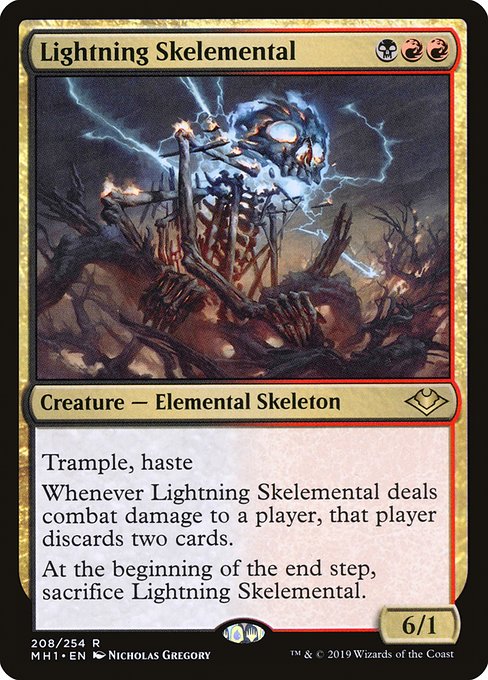
Image courtesy of Scryfall.com
Design Language of Rarity Indicators in Modern Horizons: A Closer Look at Lightning Skelemental
Rarity in Magic: The Gathering is more than a label slapped on a card. It’s a compact design signal that tells you how hard a card is to replace, how aggressively it wants to swing for the fences, and how much you should respect it in a draft or a constructed deck. When you crack open a Modern Horizons pack and lay eyes on Lightning Skelemental, you’re not just seeing a 3-mana behemoth with double red and black mana in its cost. You’re witnessing a deliberate design language at work: a rare creature that screams power, while also hinting at the risk baked into its high-octane package. 🧙♂️🔥
Lightning Skelemental is a Creature — Elemental Skeleton with a blood-and-fire pedigree: a mana cost of {B}{R}{R}, a 6/1 body, and two instantly impactful abilities. It arrives with haste and trample, two keywords that telegraph “attack now, worry later.” The card’s color identity is a bold black-red fusion—perfect for edges-of-the-table strategies that love to pressure opponents while digging for payoff. The rarity, labeled as rare in Modern Horizons (set mh1), is not just about scarcity; it’s about signaling the creature’s role in a meta where tempo and inevitability collide. ⚔️💎
“Rare cards are the loudmouths of the battlefield: they show up fast, often hit hard, and demand you bring your A-game to answer them.”
In limited formats, the rarity indicator helps players calibrate risk. A rare like Skelemental often occupies a sweet spot: enough raw power to threaten immediate damage, but with a fragile edge—this one’s 6 power for 3 generic mana is scary, yet it dies to a stiff breeze of targeted removal or a well-timed sweeper. The end-step sacrifice clause also reinforces white-knuckle decision-making. You swing with impunity, push your opponent to use their resources, and then lose the threat to the last line of the turn. That trade-off is a hallmark of rarity language in this era: big impact with meaningful cost. 🧙♂️🎲
Rarity as Strategy, Not Just a Label
Lightning Skelemental encapsulates a design principle that’s stood the test of time: rare cards signal a high ceiling, but they expect a certain level of risk. The double-color identity (B and R) aligns with the set’s ethos of mash-up mechanics and volatility. In practice, this means your deck-building choices around Skelemental should lean into synergies that push damage through while ensuring you can leverage the discard trigger to destabilize your opponent’s hand. When Skelemental deals combat damage to a player, that player discards two cards. That effect doesn't just punish early fetches—it's a nudge toward longer games where inevitability can be converted into card advantage for you and card disadvantage for them. It’s a subtle nod to the “rarity equals power, but not guaranteed win” balance that keeps games tense until the last card is drawn. 🧙♂️🔥
The modern design language of rarity indicators isn’t confined to the text box. The card’s frame (2015-era black border), foil vs. non-foil finishes, and the rarity symbol near the mana cost all play a part in how players perceive value. Modern Horizons' drafting-invention approach was about bringing forward innovative cards that still felt anchored in MTG’s core calculus: if you’re going to invest three mana in a creature with haste and trample, you better plan on applying pressure quickly and punishing mistakes. The rare designation nudges players to respect Skelemental as a potential game-ending threat, especially when combined with other red-black tools that reward aggression and resource denial. 💎⚔️
From a collector’s perspective, Skelemental’s rarity also hints at future reprints, foils, and the ongoing conversation about value in a set that blends reprint potential with new ideas. The card sits in Modern Horizons’ draft-invention ecosystem as a rare treat—easy to miss in a crowded draft, but unforgettable once it lands and starts forcing decisions on both sides of the battlefield. The foil version, priced higher, often becomes a coveted piece for players who want both power and aesthetics in their collection. The beauty of rarity indicators is that they give you a heuristic: power level, playstyle expectations, and long-tail value, all wrapped in a single glyph on the card. 🧙♂️💎
When you pair Lightning Skelemental with the broader line of MH1 cards, you begin to see how rarity indicators shape deck archetypes and metagames. The design message is clear: if you want to ride the wild-storm wave of red and black, you’ll need to balance aggression with careful hand disruption and strategic sacrifice timing. This is why rarity indicators matter not only in the heat of a match but in the narrative of the set’s design language. They tell you what a card wants to do, how reliably it can do it, and what kind of risk you’re inviting into the party. 🎨🧙♂️
Custom Neon Rectangular Mouse Pad 9.3x7.8 inAnd while you’re storming the board, why not keep your play space as radiant as the cards you love? A neon mouse pad like the one above isn’t just a desk accessory—it’s a reminder that MTG’s tactile joy deserves its stage. The glow of a well-lit play desk pairs perfectly with the flash of a rare trick like Lightning Skelemental, turning casual games into a little theater of strategy and spectacle. 🎨💥
Five Ways Lightning Skelemental Inspires Rarity-Language Thinking
- Two-color identity signals a multi-color strategy that rewards careful mana development.🧭
- Haste and Trample on a 3-mana investment deliver immediate battlefield pressure.⚡
- The discard-on-damage clause enshrines risk-reward—draws-out combat decisions that swing both players’ resources. 💥
- End-step sacrifice keeps the board dynamic, encouraging timely recasts or replays rather than stale loops. ⏳
- Foil vs non-foil presentation underlines collectible value alongside raw power. 💎
More from the Network
- https://crypto-acolytes.xyz/blog/post/top-sega-arcade-games-everyone-should-play/
- https://transparent-paper.shop/blog/post/deploying-your-first-saas-product-a-practical-guide/
- https://blog.digital-vault.xyz/blog/post/red-tinged-hot-giant-at-2-kpc-cross-checked-with-ground-spectra/
- https://crypto-acolytes.xyz/blog/post/exploring-nft-museums-in-the-web3-metaverse/
- https://blog.digital-vault.xyz/blog/post/mistmeadow-vanisher-design-lessons-from-playtest-feedback/